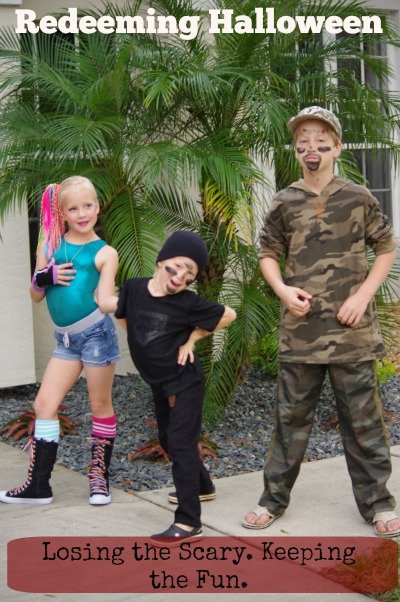I must confess up front that I’ve long had a bit of difficulty loving Halloween.
There are a lot of things about this particular holiday that stress me out, from the gigantic bags full of candy that my children do not need, to the crazy scary costumes and decorations that people put up in their yards. I’m baffled by beautiful homes that are transformed into makeshift graveyards. A palm tree is a gorgeous piece of landscaping, so it confuses me when I see a bloody head hanging from the branches come October 1.
And don’t even get me started on the house in our neighborhood that hangs the scariest looking zombie man over their front door, and sets two bloodied zombie mannequins in the front yard, which they light every night throughout October with strobe lights while evil laughter cackles through a speaker.
These are things I just don’t understand.
There are, however, things that I love about Halloween. The official kick off of fall is the first thing. While we don’t get much of the crisp air here in Florida, we do get a reprieve in the weather. Plus, PUMPKIN EVERYTHING!
Pumpkin spice lattes, pumpkin pie, pumpkin scented candles, actual pumpkins. Even the Florida heat cannot put a damper on my love of all things pumpkin.
Also, I do love dressing up my children in cute little costumes. No zombie brides for us, thankyouverymuch, but a Punk Rock Gymnast and last minute, homemade Duck Dynasty costumes? Yes, please!
A few years ago, I set out on a quest to understand more about the history behind Halloween. How did the scary-evil get started, and why? I stumbled across a resource that has since become my source of rescue. It is a book title Redeeming Halloween, and was put out by Focus on the Family as a way to educate families on the history of this holiday, and offer tips on ways to enjoy it without diving too much into the darkness.
First, it’s significant to remember the origins of Halloween in order to best understand why we celebrate it in the first place. In A.D. 741, All Hallows, or All Saints Day, was moved on the calendar from May 13 to November 1. The night before All Saints Day was given the reverent title of “All Hallow’ een,” or “the eve of the holy ones.”
It was a time to remember those who had been martyred for the Christian faith. It was a holy time of honor and remembrance. So…what changed?
The stories on the origins of trick or treating are varied, but the most popular historical account traces this practice back to the mid-1800’s when a large population of Irish immigrants who had come to America brought their practice of “mumming” or “masquerading” to the streets of the U.S. Sometimes referred to as “mischief night,” many young people roamed the towns in costume pulling generally harmless pranks, and offering up short plays in exchange for food or drinks.
By the 1920’s this practice grew more harmful, with the pranks becoming more vandalizing and destructive. In an effort to curb this unwanted practice, several neighborhoods and organizations began organizing a night in which “good” children were encouraged to dress up in costume and visit shops and homes to receive treats. At each place they stopped, these children would yell “trick or treat,” and thus a uniquely American tradition was born. To keep uniformity, it was given a place on the calendar.
October 31. All Hallow ‘een.
Halloween.
Of course, there were other pagan practices that infiltrated what was meant to be a holy holiday, but knowing that the roots of this holiday were meant to be more innocent than evil allows me to better guide my children in enjoying it.
One of the ways we do this is by keeping our costumes fun and innocent. I don’t really want to see my children dressed up as bloodied dead people. It creeps me out.
Generally we also try avoid the really scary houses, because I enjoy sleeping and prefer not to be awoken by nightmarish children for a month following what is supposed to be a fun night.
We laugh a lot as a family, enjoy a time of celebration with our neighbors, and eat too much candy. The next morning, we ration the candy out for a couple of weeks. My children don’t ever eat all the candy they receive because our dental bill is high enough already, so after two weeks of enjoying two small pieces a day, we donate the rest of the candy to ministries or dental offices who offer to ship it to our soldiers overseas.
Halloween still isn’t my favorite holiday, but we’ve made enough modifications to how we celebrate that I’ve come to enjoy the event over the years rather than dread it. The worst part, now, is getting them to decide on a costume before the big day rolls around.


Leave a Reply